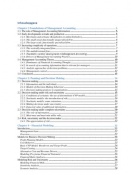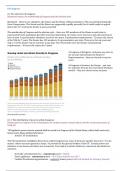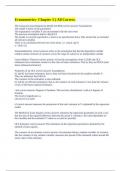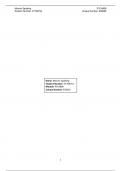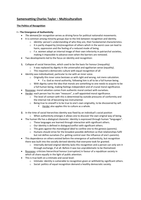Question 1 False: Probability values must fall between 0 and 1, inclusive. 0.25, and 1.21 do not
meet this criterion.
Question 2 True: If events are independent, knowing one event occurs does not affect the
probability of the other event occurring. Here, the events rolling a number in set A or rolling a
number in set B are independent.
Question 3 False: Mutually exclusive events cannot occur simultaneously. However, event A
(rolling a number in set A) and event B (rolling a number in set B) can overlap (e.g., rolling a 1
satisfies both events), so they are not mutually exclusive.
Question 4 True: The complement of an event is the probability of that event not occurring. If
the probability of rain is 45%, then the probability of no rain (complement) is 1 − 0.45 = 0.55,
not 0.45.
Question 5 False: Events A and B are mutually exclusive if their intersection is empty. Here,
if 𝑃(𝐴 ∩ 𝐵) = 0.1, then A and B are not mutually exclusive.
Question 6 False: Events A and B are independent if the probability of B occurring given that A
has occurred is equal to the probability of B occurring. Here, 𝑃(𝐵|𝐴) = 0.4 , which is not equal
to 𝑃(𝐵) = 0.4 so events A and B are not independent.
Question 7 False: If the probability of an event or its complement is 1, it means that the event is
certain to occur. However, the given table does not provide enough information to determine
the probability of either event or its complement being 1.
Question 8 False: Mutually exclusive events cannot occur simultaneously, but the total count in
the contingency table suggests overlap between events A and B, making them not mutually
exclusive.
Question 9 True: If the contingency table provides 𝑃(A ∩ B) = 0.33, then this represents the
probability of both events A and B occurring.
Question 10 True: The expression that describes both events occurring is A ∩ B, which means
the intersection of events A and B. So, the correct expression is A ∩ B.
Part B
Question 1
a)
(i) 𝑃(𝐴 ∪ 𝐵) = 𝑃(𝐴) + 𝑃(𝐵) − 𝑃(𝐴 ∩ 𝐵)
𝑃(𝐴 ∪ 𝐵) = 𝑃(𝐴) + 𝑃(𝐵) − 𝑃(𝐴)𝑃(𝐵) (Since A and B are independent)
3 3 3 3
𝑃(𝐴 ∪ 𝐵) = + − ×
6 6 6 6
1 1 1
𝑃(𝐴 ∪ 𝐵) = + −
2 2 4
2 2 1
𝑃(𝐴 ∪ 𝐵) = + −
4 4 4
3
𝑃(𝐴 ∪ 𝐵) =
4
(ii) 𝑃(𝐴 ∪ 𝐶) = 𝑃(𝐴) + 𝑃(𝐶) − 𝑃(𝐴 ∩ 𝐶)
𝑃(𝐴 ∪ 𝐶) = 𝑃(𝐴) + 𝑃(𝐶) − 𝑃(𝐴)𝑃(𝐶)

